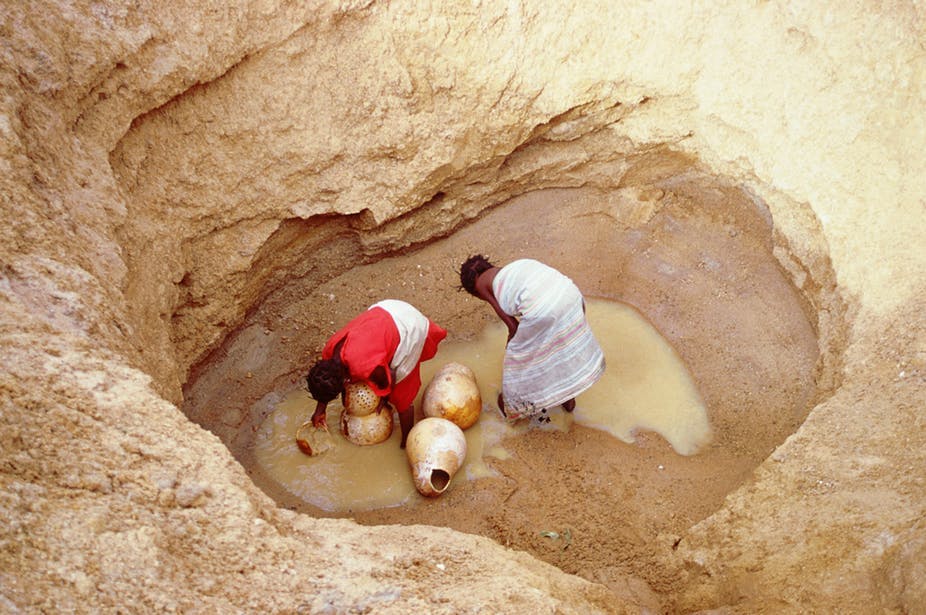Today, dry areas represent more than 41% of land on the globe and they are home to more than two billion people.
They are the stage for the ongoing process of land degradation that is aggravated by climate fluctuations – particularly drought – and pressure exerted by human activities (including demographic growth and inappropriate management of natural resources). All of these factors strongly undermine the capacity of populations to adapt to an increasingly difficult environment.
In Africa in the 1970s, droughts had terrifying consequences in an already fragile context. The images of their effects still mark collective memory today. They were a determining factor in the holding of the United Nations Conference on Desertification in Nairobi in 1977.
Beyond recognition by the international community (since the Rio Earth Summit in 1992, with the adoption of the United Nations Convention to Combat Desertification), we also face the question of our understanding and evaluation of the desertification process, and of sustainable solutions to fight it. The recent inclusion of the concept of “neutrality” in terms of land degradation in the United Nations’Sustainable Development Goals makes the battle against desertification a major issue for development, (re)connecting societies and environments, and human well-being.
Millions of hectares are disappearing
The situation is particularly sensitive in sub-Saharan countries, where over 80% of the economy is based on subsistence farming. According to Monique Barbut, UNCCD Executive Secretary, emphasised that almost 12 million hectares of arable land are being lost each year globally, to desertification and drought, when 20 million tonnes of cereals could have been cultivated on this area.
La dégradation des sols, un problème planétaire qui affecte deux milliards d’êtres humains @ird_fr @UnivParisSaclay https://t.co/39F0OijrzA pic.twitter.com/yoWQv00ic0
— Conversation France (@FR_Conversation) July 6, 2017
Despite the diversity and intensity of efforts to combat desertification, the challenge of land degradation in a time of climate change in Africa’s arid areas remains unresolved. The environmental and societal stakes are massive, including food security, climate change, health, law and social equity.
However, the progressive growth of knowledge about the causes, mechanisms and consequences of desertification now allows us to devise new solutions, particularly when it comes to combating land and soil degradation.
Good practices to adopt
The success of such projects and programmes combating land and soil degradation depends on an understanding and evaluation of the situation in the territory concerned. This assessment prior to action should allow us to determine the type of degradation anywhere, its severity, its temporal dynamics, its spatial distribution according to the degradation factors, and the types and intensity of consequences both locally and at regional and international levels. This approach is indispensable for effective action.
Sustainable land and water management practices over recent decades have improved our ability to combat desertification and preserving natural resources. However, efforts still need to be made, particularly to create a favourable socio-economic environment to support, promote and deploy such practices over larger regions.

To assess the state of knowledge on these issues, the Sahara and Sahel Observatory (OSS) and the French National Research Institute for Sustainable Development (IRD) recently produced a report, “Desertification and Earth System: From Knowledge into Action”, that offers an unprecedented situational analysis. It can be consulted online or downloaded free of charge.
Achieving neutrality
The fight against desertification and land degradation requires the consideration of several temporal and spatial scales (from the agricultural plot and the basin, to farming, to village, communal, local, national or regional land), and levels of decision-making (from the family unit and local or regional government, to the State and international convention). It also must take into account various level of action and management, whether it be in understanding the mechanisms of land degradation, in the action itself or in its scientific, technical, administrative or political management.
Given recent technological innovations and human ingenuity, desertification is not an inevitability. However, nothing significant will happen if scientific, political and citizen mobilisation is not sustainably coordinated.
By starting work today on sustainably managing land and restoring degraded land, it is nevertheless possible to reach land-degradation neutrality by 2030. On this subject, it is worth consulting the report presented on 14 September during the UNCCD Conference of Parties in Ordos (China), devoted to sustainable land management for humans and the climate.
 The authors do not work for, consult, own shares in or receive funding from any company or organisation that would benefit from this article, and have disclosed no relevant affiliations beyond the academic appointment above.
The authors do not work for, consult, own shares in or receive funding from any company or organisation that would benefit from this article, and have disclosed no relevant affiliations beyond the academic appointment above.



 Swimming in the sweet spot: how marine animals save energy on long journeys
Swimming in the sweet spot: how marine animals save energy on long journeys  Lake beds are rich environmental records — studying them reveals much about a place’s history
Lake beds are rich environmental records — studying them reveals much about a place’s history  Ukraine minerals deal: the idea that natural resource extraction can build peace has been around for decades
Ukraine minerals deal: the idea that natural resource extraction can build peace has been around for decades  Extreme heat, flooding, wildfires – Colorado’s formerly incarcerated people on the hazards they faced behind bars
Extreme heat, flooding, wildfires – Colorado’s formerly incarcerated people on the hazards they faced behind bars  Ethereum Ignites: Fusaka Upgrade Unleashes 9× Scalability as ETH Holds Strong Above $3,100 – Bull Run Reloaded
Ethereum Ignites: Fusaka Upgrade Unleashes 9× Scalability as ETH Holds Strong Above $3,100 – Bull Run Reloaded  U.S. Black Friday Online Spending Surges to $8.6 Billion, Boosted by Mobile Shoppers
U.S. Black Friday Online Spending Surges to $8.6 Billion, Boosted by Mobile Shoppers  India’s IT Sector Faces Sharp 2025 Valuation Reset as Mid-Caps Outshine Large Players
India’s IT Sector Faces Sharp 2025 Valuation Reset as Mid-Caps Outshine Large Players 

































